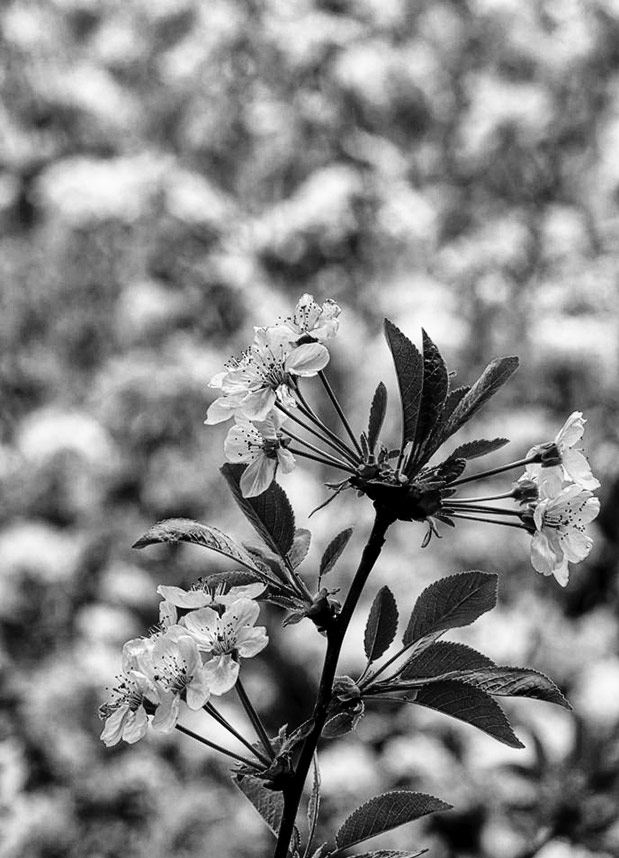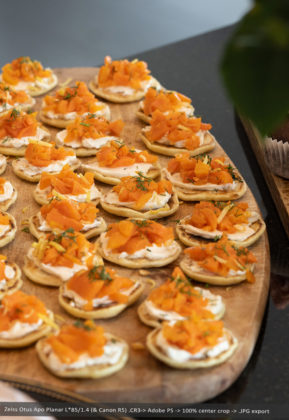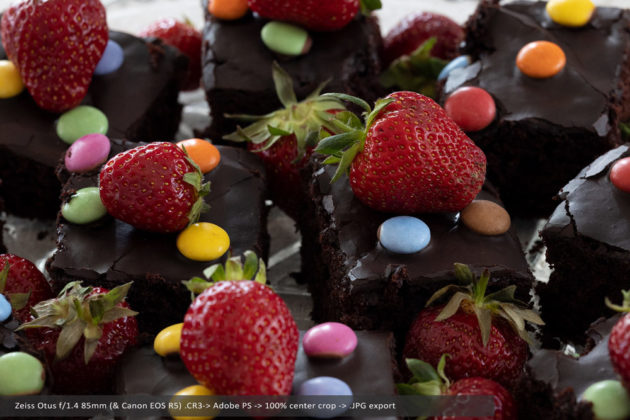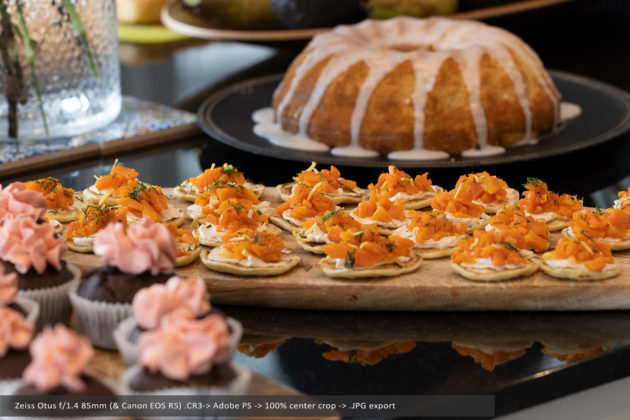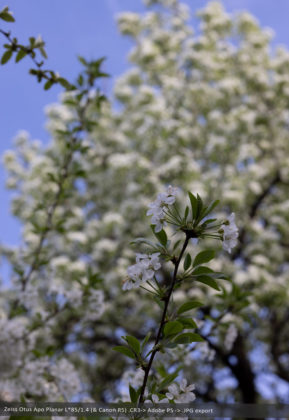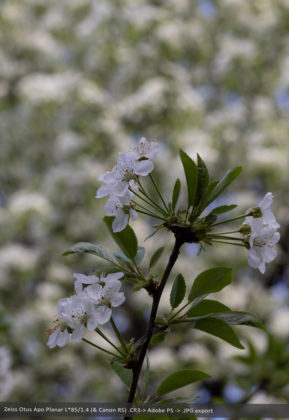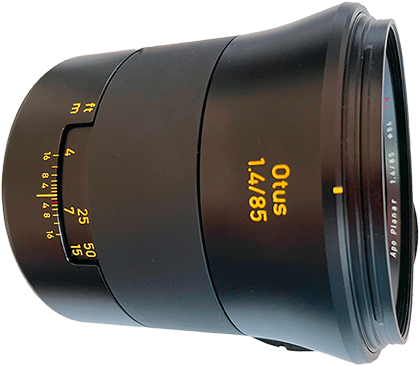Lens overview
The ZEISS Otus 1.4/85 Apo‑Planar arrived in September 2014 for Canon EF (ZE) and Nikon F (ZF.2), explicitly built to deliver medium‑format‑like performance on high‑resolution DSLRs. The optical formula is 11 elements in 9 groups, including one aspherical element and six anomalous partial‑dispersion elements to achieve apochromatic correction. It focuses down to 0.8 m, uses 86 mm filters, and stops f/1.4–16 with a 9‑blade diaphragm. Typical weights: ~1200 g (ZE) and ~1140 g (ZF.2); angle of view (diag.) ≈ 28.24°. At launch, MSRP was US $4,490. Production units are marked “Made in Japan,” with Cosina widely reported as the manufacturing partner for Zeiss’s DSLR lines. Zeiss Otus lens family.
Why it matters: Otus glass is tuned to minimize longitudinal/transverse CA, field curvature, and focus shift so that wide‑open images look “finished” without relying on stop‑down. In practice, that translates to unusually high micro‑contrast and crisp transitions at f/1.4.
Build and ergonomics
The Otus 85 feels like a precision instrument: a deep‑helical ~260° focus throw (longer than many cine primes), hard‑anodized metal barrel, engraved scales, and internal focusing that preserves balance. The ZF.2 version adds a mechanical aperture ring plus CPU contacts; ZE (EF) uses electronic aperture control. Either way, the tactile focus is addictive and repeatable—critical at f/1.4 with millimetric depth-of-field control.
Optical performance
Resolution & contrast. This lens is famously excellent at f/1.4, already resolving fine textures with very high micro‑contrast; stopping down to f/2–2.8 mainly increases corner uniformity. It’s one of the few ’85s where “wide open” isn’t a compromise.
Chromatic aberration & color. The apochromatic design and glass mix suppress LoCA/fringing to near‑invisibility in typical use; color is neutral without the magenta/green spill many fast 85s show. Lightroom/ACR has built‑in Otus 1.4/85 profiles; enable Remove Chromatic Aberration and, if needed, sample problematic edges with Defringe for surgical cleanup. Those same profiles take care of subtle vignetting/distortion if you prefer a “clinical” baseline before creative edits.
Bokeh & rendering. The 9‑blade diaphragm keeps out‑of‑focus highlights rounded, and the rendering is clean, neutral, and depth‑true—it doesn’t smear detail but gently lets go of it. You can see a touch of “cat’s eye” shaping toward corners at f/1.4; some samples show faint aspherical‑polish texture in pinpoint speculars under torture testing, but it’s rarely visible in everyday work.
Flare, vignetting & distortion. With T* coatings and excellent baffling, veiling flare is well‑controlled; vignetting at f/1.4 is present and visually flattering; geometric distortion is negligible and easy to profile.
Digital adaptation (EF/F → mirrorless) & IBIS
- Canon EF (ZE) → EOS R series: Use EF‑EOS R—AF isn’t relevant (the lens is MF), but EXIF and electronic aperture work perfectly. On IBIS bodies, Canon states IBIS works with all EF lenses, adding at least roll and frequently cooperating with in‑lens IS (not present here). With the Otus, stabilization comes solely from IBIS, and it helps. Enable Focus Guide/MF peaking for high‑precision MF on the R5/R6/R3.
- Nikon F (ZF.2) → Nikon Z: Use FTZ; EXIF passes via CPU, the aperture ring still works, and IBIS stabilizes.
- To Sony E/L‑mount: Use a smart EF adapter (for ZE) to retain aperture/EXIF, or a simple F→E ring for ZF.2 (aperture via ring); IBIS functions if the body supports it.
Impressions — close‑up & food photography
Close‑ups (object & product): At 0.8 m MFD the Otus gives roughly 1:7.7 reproduction with a free working distance ~0.65 m—enough space to light and style. Wide open, the lens renders hard‑edged subjects without purple/green fringing, so metallic cutlery, glazed ceramics, or foil highlights stay clean. For three‑quarter still‑life or pack shots, f/1.4–2 yields a natural fall‑off; for copy‑style detail, f/4–5.6 tightens plane‑to‑plane contrast.
Food setups: 85 mm is a sweet spot for table‑edge perspectives—close enough for detail, long enough to avoid perspective exaggeration. At f/1.4–2, backgrounds melt but edges of the subject stay honest; diffusion of backlights reads smoothly in icing, glazes, and steam. If you need a tighter MFD for hero shots of small items, add a short extension tube (e.g., 12 mm on EF)—you’ll keep the Otus look, just be mindful of reduced infinity and the razor‑thin DoF.
Manual focus workflow: On mirrorless, turn on Focus Guide and 10× magnification, then rack through and come back (the long throw and flat field make critical focus surprisingly repeatable). On a tripod, IBIS can remain ON; for very long exposures, you may prefer it OFF to avoid micro‑corrections.
Otus 85 (ZE/ZF.2) vs the new Otus ML 85/1.4 (mirrorless)
ZEISS resurrected the line in 2025 with Otus ML primes designed natively for E / RF / Z mounts. The ML 85/1.4 keeps the ethos but changes the mechanics and optics.
- Mounts: ML ships native for Sony E, Canon RF, Nikon Z—no adapters. The classic Otus remains EF/F only.
- Optics: ML 85 uses 15 elements / 11 groups (vs 11/9), promising even better edge correction on mirrorless stacks.
- Diaphragm: 10 blades (ML) vs 9 blades (classic)—slightly rounder stopped‑down highlights.
- MFD/throw: 0.8 m MFD remains; focus throw ~244° (ML) vs ~261° (classic).
- Size/weight & filters: ~1.03–1.04 kg and 77 mm filters for ML, versus 1.14–1.20 kg and 86 mm for the classic.
- Price at intro: US $2,999 (ML 85) vs $4,490 (classic, 2014).
Bottom line: If you work mirrorless‑only, the ML simplifies life (smaller filters, native mount, 10‑blade iris). If you already own the classic and love the ergonomics, there’s no urgency—it’s rendering still competes at the very top.
Historical & collector context
Otus, as a project, was never about one lens; it was a statement. ZEISS set out to build primes that would stay optically honest at full aperture on the highest‑resolution sensors—no excuses, no reliance on stopping down. The opening shot was the Otus 55 mm f/1.4 (Apo‑Distagon) in 2013, a deliberate choice of a retrofocus “Distagon” scheme at a standard focal length to control oblique rays, field curvature, and axial color in ways classic double‑Gauss designs could not. Its files—wide‑open—had that “finished” look: high micro‑contrast, neutral color, and edges that didn’t fall apart when you pushed them. The Otus 85 mm f/1.4 (Apo‑Planar) arrived as the portrait counterpart, translating the same ethos to short‑tele: apochromatic control, low field curvature, and a rendering that felt more medium‑format than 35 mm.
Against that background, the Canon FD 85 mm f/1.2 L (1980) reads like a beautiful first draft from a different era. It’s lighter, more compact, and its ground aspherical + floating focus can look magical at f/1.2—but it also carries the period’s compromises: pronounced axial CA wide open, a touch of veiling flare in hard backlight, and a softer discipline at the frame edge. By design, the Otus 85 trades some of that romantic glow for color fidelity, edge integrity, and consistency; it’s a tool you pick when you want the picture to be about your light and subject, not the lens’s temperament. In practical use, the FD 1.2 L is the poet; the Otus 85 is the surgeon.
Within the line itself, the Otus 55 vs. Otus 85 split is clear: the 55 sets the benchmark for micro‑contrast and plane‑to‑plane flatness at a general‑purpose focal length; the 85 adds longer‑lens separation and smoother highlight geometry for portrait and still‑life work. Both became reference points in independent testing—and both anchored the Otus reputation for a decade.
The ML relaunch (2025) brings that philosophy to native mirrorless mounts, tightening mechanics and usability while easing cost and size (smaller filters, updated diaphragm, native EXIF control). For collectors and working shooters, that leaves a healthy ecosystem: the classic ZE/ZF.2 Otus 85 remains a prestige manual‑focus instrument that holds value and character; the Otus 55 stays the gateway to the series; and the ML versions offer the same optical doctrine with modern convenience.
Field-tested tips
Adapters: EF‑EOS R is seamless for ZE; for Sony E, a dependable EF‑E “smart” adapter preserves aperture & EXIF.
Food & still life: start at f/2–2.8, place your key light high and behind for specular control, and let the Otus draw the edge transitions; use 86 mm slim CPL/ND to avoid hood interference.
Handheld portraits: rely on IBIS when adapted; add a monopod for repeatability at 1/125 s and slower.
Focus discipline: focus slightly past and roll back—focus‑shift is negligible, but this improves keeper rate with ultra‑shallow DoF.
Sample photos
Verdict — Pros & Cons
Pros
- • Real f/1.4 acuity and micro‑contrast; apochromatic control of color fringing
• Nine‑blade bokeh with graceful fall‑off and neutral color
• Exquisite manual‑focus feel; internal focus; robust metal build
• Adapts cleanly; IBIS + Focus Guide make precision practical
Cons
- • Heavy (~1.2 kg) with 86 mm filters—bring a strap or monopod for long days
• Manual focus only; not ideal for fast, chaotic motion
• Premium price (even used), though it holds value


